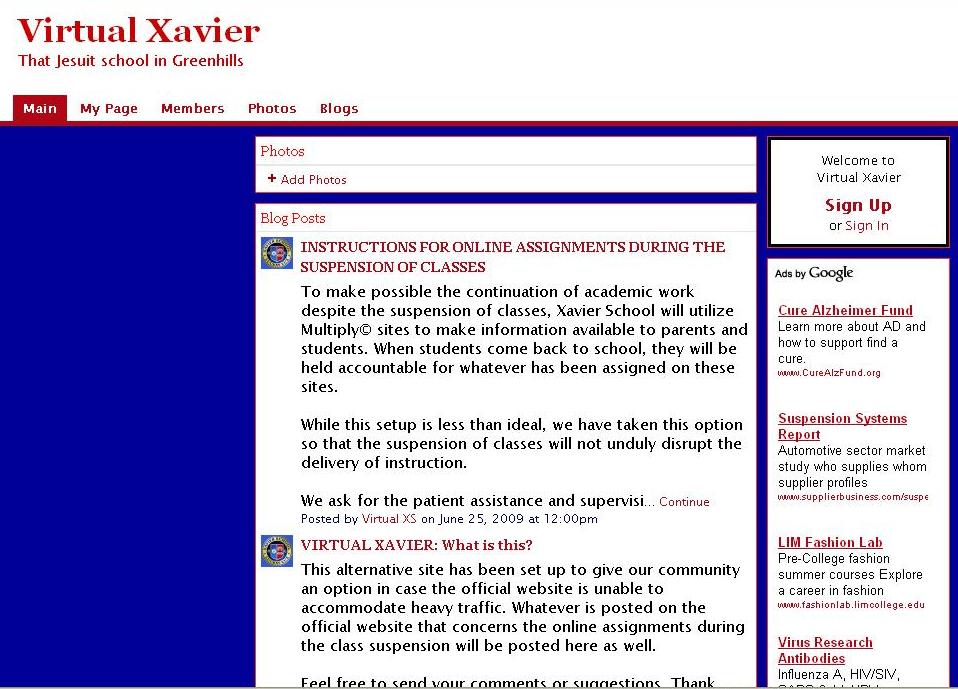Many mothers like me here in the Philippines are growing more and more worried by the day as the number of people becoming sick with the A(H1N1) virus increases. Classes have just began in our part of the world and in the first week, some students were found positive resulting in classes being suspended and moved by about 10 days.
In the university where my girls go to school, there were initially 3 high school cases but another case was confirmed yesterday. So far, the school where my boys study has been virus-free but as more and more schools confirm cases of their students getting sick, I worry.
However, I have suggestions for school administrators and teachers especially in schools that are well-equipped to use technology and the internet. You can have a back-up plan to ensure that in the event you will be forced to suspend classes, your students do not lose too many days out of school. This will require a paradigm shift in the way you conduct classes but it can work.
You can shift to the web.
Of course, many of these moves may require coordination with DECS but just think of the possibilities:
1. Email addresses and mobile numbers serve as point-to-point contact – Many schools, as part of information sheets during enrollment, ask for the email addresses and mobile numbers of parents & students. Take this to the next level. Use your database of email addresses of all your students/teachers/administrators/parents and create mailing lists now. One mailing list for faculty, another for parents, another for students (by level). This will be one of your ways to disseminate information.
2. School websites are not just for information; they can be transformed into online classrooms. – A few days ago, the boys’ school held parent orientations. I did not go. I was feeling under the weather and chose to stay away from crowds. But I heard that the orientations did not last long. The class advisers went through powerpoint presentations to introduce the line-up of teachers as well as answer a few questions from the attending parents.
Now this got me thinking. If that was all it took during orientations, why could we not have put this same information up on the website of the school, giving access to parents via some form of security code?
I remember the inauguration of Pres. Barack Obama. CNN created a Facebook page linked to its website. Any Facebook users who subscribed to the page could literally jump into a chatroom as the inauguration was going on and add his/her comments to the global community. Bring that down to a school community.
Could we create a smaller version of a chatroom so that parents could do conferencing with the school administrators/faculty as they are viewing a presentation?
Could Powerpoint presentations be simply uploaded to the website for parents to access?
Could the teachers have made podcasts/videos of what they wanted to say to parents as well?
Can lessons be broadcast via podcasts or YouTube?
3. Think ONLINE QUIZZES!!! – Yes, there will be issues like: Do we really know if it is the student answering the quiz or not since he is not visible to the teacher? But maybe with proper sanctions in place for those found cheating, or with appropriate security codes/log-in requirements, students can take quizzes online. Cheap webcams can be required so that a student would be visible via webcam to his teacher while taking an exam. Grading would be a cinch too since the correct answers can be keyed into a program that does instantaneous checking of papers.
4. Collaborative tools make team-based projects easy online. – Google Docs is one example of a collaborative tool. Word documents, spreadsheets and presentations can be created and shared online. Team members can all view the same document, make changes, chat online about it and essentially, collaborate. No need for face-to-face interaction.
5. Use Mobile broadcasting for important announcements – Many schools in Metro Manila utilize this tool already. Parents/students/faculty subscribe to the service and important announcements from the school are pushed via SMS to the subscribers. While mobile broadcasting nowadays is in the form of school cancellations, event announcements and the like, this can be used also to alert parents and students to check the school website for newly posted classroom activities.
This internet mode of schooling is, of course, a temporary measure and can be utilized only in extreme cases when the school is forced to suspend classes for long stretches. But if the DECS accepts this as an alternate mode of schooling, cases like the A(H1N1) pandemic need not interrupt school days drastically.
At the moment, I also realize that it is the private schools that would have the advantage in implementing this over public schools due to their access to technology and computers but we can start from here.
Leave a comment if you have other ideas as to how classes can be conducted online to reduce the interruptions.



